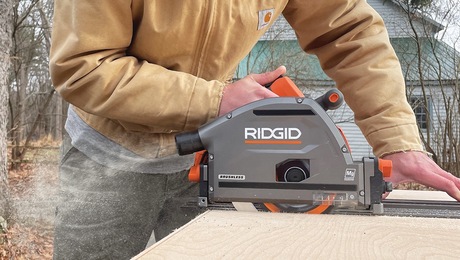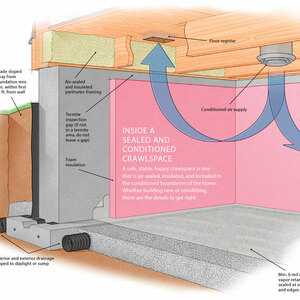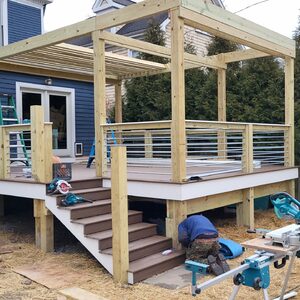I’m installing gas piping for Natural Gas to some heaters and a gas range. This is new construction .. my addition to my house. I’m never done piping before and my question is this: When tightening down the 3/4″ or 1/2″ pipe into a coupling or a turn or whatever, should one go for “as tight as humanly possible”? I always wonder if I should reaf on it after it feels quite tight or figure that once it feels ‘towards the end’ I should let it go as ‘good’? I have tended to tighten all joins as much as possible since the idea of gas escaping into the walls is spooky. But it has occured to me that this could lead to some kind of ‘binding’ or eventual breakdown(?) There MUST be a ‘traditional approach’ to this and I’m wondering what it is. (I am speaking specifically of black pipe joined with white plumber’s paste, by the way.) Thank you! NB
Discussion Forum
Discussion Forum
Up Next
Video Shorts
Featured Story

The best tool for straight, splinter-free cuts is made even better without a cord.
Featured Video
How to Install Exterior Window TrimHighlights
"I have learned so much thanks to the searchable articles on the FHB website. I can confidently say that I expect to be a life-long subscriber." - M.K.

















Replies
You're using gas tape and/or
You're using gas tape and/or pipe dope, correct? You don't need to make the joints "as tight as humanly possible", and I wouldn't because you may crack a fitting that way. You do need to put wrenches on it, but not a whole lot of muscle. Buy an air test gauge and use it to test your work partway thru, so you can see what you have.
You could put some soapy water on the joint to see if it leaks.
-h
Take a close look at the threads on a pipe nipple and you will see that they are slightly tapered, as are the female threads of a fitting, but those are harder to see. This makes it easy to start a fitting onto the pipe end, but more importantly, it makes for a better seal as you tighten the joint.
When you use pipe dope, any little imperfections in the threads will be taken care of and the lubricity of the stuff enables another 1/2 turn or more of tightening with the same force.
On 3/4" or smaller pipe, you should get a good seal with moderate force (no jumping on it, bouncing, hammering or handle extensions) using a 12" pipe wrench. you can even back off a little to align an elbow without concern.
As one of the other posters said, use liquid leak tester (or the kids' bubble blowing solution or dish detergent diluted 4:1) swabbed onto the joints with a brush and look for any bubbles.
Have you checked the BTU requirements of the devices and calculated the necessary pipe size for a given distance of run? Here is a link to pipe sizing chart.
http://home.mchsi.com/~gweidner/pipe-sizing-chart-ng.pdf
You need to work out the CFH available at the existing piping where you are going to start the new run to be sure that there is enough there to supply all three devices if they are running at once, then size the new run(s) so that each device gets enough flow. A 3/4" elbow counts as equivalent of 2 feet of pipe.
1 cu ft = approximately 1000 BTU
Hello-
Yes I am using the appropriate pipe dope. I've had an inspector -- the chief inspector for a large metropolitan area actually -- come see the work. I've been passed on all supply and drainage lines in a complicated scenario of two full baths on upper floors of a four floor structure involving a lot of criss-crossing with fan and vent piping, electrical, cable and what have you. Now it's down to the gas piping and it will not be testable until it is all in and sealable. So .. no bubble solutions. What I've done thus far is not even hooked up to the meter.
I've been tightening things such that they cannot be turned much further without really reefing on them. I'm using only 12" pipe wrenches. It seems wrong to have to back something out a third of a turn to align it properly so I've TRIED not to do that but have in some very few instances. Some part of me thinks that in backing it off I am 'opening' some metal-to-paste seal and that this will end up a leak in the long run. I hope that I am wrong on that. I hear that peaple are pretty much saying to continue as I have been: tight .. but not crazy jump up and down on it attach a 6 foot pipe to it and use a sledge tight.
Thanks again -
n
By the way .. brucet9, THANK you for that pipe sizing chart. Now I know what my inspector was concerned about. I shoulda seen that months ago. That's a keeper - simple, straightforward, understandable.
Much appreciated!
N
another (sub) question to this thread:
It says on the pipe sizing chart that an elbow is worth 'this' much and a 't' is worth 'that' much. But what about a coupling on a straight run. Would the slight disturbance to the integrity of the sides of the piping 'coount' for anything? Or is this simply considered 'straight pipe'???
Anybody know?
thanks
Couplings have no measurable effect on flow.
The effect of elbows and tees varies with pipe size. As pipe size increases, so does its resistance to gas flow, but elbows and tees still cause a lot of resistance, so the pipe-lenght equivalent goes up as pipe size increases.
3/4" pipe elbow = 2 feet. 4" pipe elbow = 5 feet.
If you are slowly working on the piping I'd suggest you cap and pressurize everything as you go. A small leak will show up over night as a drop in the psi--use a gauge made for gas line testing--it will already be attached to a 3/4" pt fitting and has an air nippple. (can I say nipple?)
Rough fittings sometimes require more torque to seal properly--sometimes a plumber will get a rough batch and cus the leaks and have to work backwards horsing on the fittings a little extra.
Test for yourself---put a pressure test on a short section of pipe and try tightening little by little until the joint holds air. Along the same lines screw a few short sections of pipe into fittings until they crack--you will learn a lot.
Use as little force as possible but as much as neccessary. :)
That's a great idea to
That's a great idea to intentionally experience a 'cracking'of a fitting. Is it completely obvious? Or can a 'hairline' crack form without one even knowing it?
N
The few fittings I've cracked
The few fittings I've cracked were quite noticable when it happened because the force to turn the pipe changed. Can't say I remember any noise that could be heard over my grunting :) I suppose that if someone stopped just as the fitting barely started to fail an invisible hairline crack would exist.
I typically have a problem of over tightening brass fittings and under tightening iron--I suspect we all have a bias.